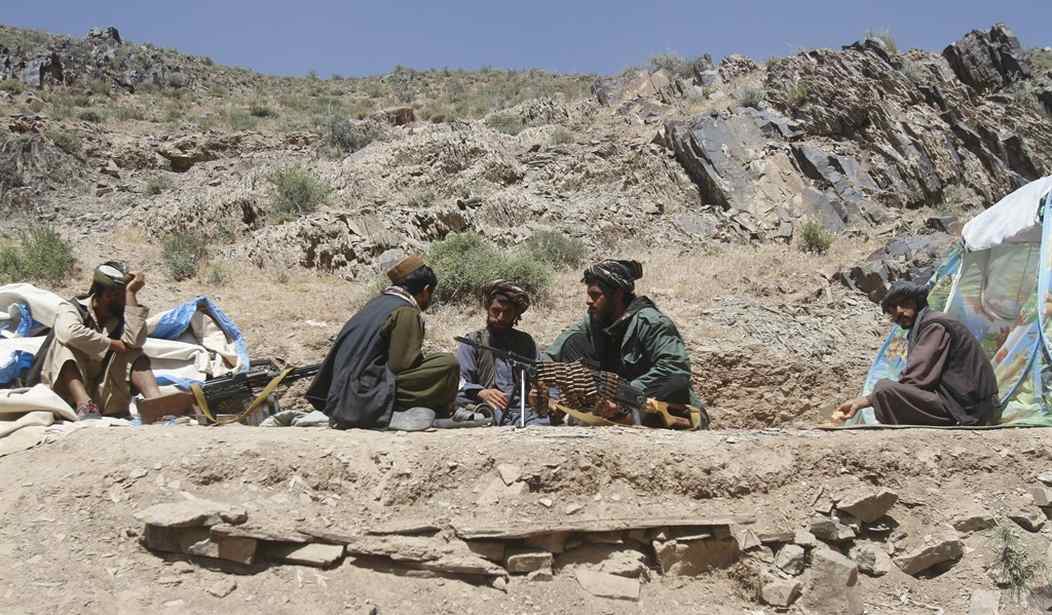So …. how’s that deal with the Taliban looking? Just outstanding — if you’re the Taliban. With the US packing up and leaving Afghanistan, the extremists have gobbled up large chunks of territory, and now have control of the capital of Nimruz province.
Thanks to a prison break, they also have replenished their ranks:
Taliban fighters seized control of the capital of Nimruz province in southwestern Afghanistan on Friday, the first provincial capital to be overrun by the militants since the withdrawal of U.S. and NATO forces from the country.
Rohullah Gul Khairzad, the province’s deputy governor, said the city “has fallen” to the Taliban, but he refused to release further details.
Unconfirmed videos circulating on social media show residents looting shops in a central market in Zaranj, the provincial capital. One Afghan security official said clashes in the city are continuing. He spoke on the condition of anonymity because he was not authorized to discuss ongoing operations with the media.
The violence triggered a prison break in Nimruz, but the official said the most notorious inmate had already been transferred to Kabul. The Taliban has prioritized prison raids to replenish the insurgents’ ranks and dent the morale of Afghan security forces.
The New York Times calls this a “symbolic” victory, for some reason:
The seizure of Zaranj is a symbolically significant development in the Taliban’s campaign, as they moved away from targeting rural districts to focus on attacking provincial capitals, with Zaranj being the first to fall.
The 215th Corps of the Afghan National Army is responsible for security in both Zaranj and Lashkar Gah, the capital of neighboring Helmand Province, which has been under siege for several days. The 215th Corps’ leadership had shifted its focus to defending Lashkar Gah, leaving Zaranj, a city of 160,000 people, vulnerable to capture.
“All the people are hiding in their houses in fear of the Taliban,” said Khair-ul-Nisa Ghami, a member of the provincial council. “The situation is very worrying. People are scared,” she said, adding: “The Taliban captured the city without any fighting.”
The Taliban have besieged a host of such cities for weeks, and Zaranj’s likely fall on Friday is the Taliban’s first major breakthrough. The city’s collapse came as the insurgents also pressed hard into other provincial cities, in a day of bleak news for the government.
The capture of a provincial capital and all its resources are a lot more than just a symbolic victory. This isn’t a skirmish outside of an army base or the capture of a road. The Taliban has now seized an important base from which to expand its operations while pushing the Afghan military into tough choices on how to use its declining resources and clearly insufficient forces.
That’s not symbolic at all. It’s emblematic of the failure of the past twenty years by NATO to build a lasting force that could guarantee order while Afghanistan sorts out its political differences. The US and its allies insisted that they would leave behind a central government and a native military that could protect these cities and push the Taliban to transform from a rebel army to a political party. Even after twenty years, the Taliban is as potent as ever, and the central government in Kabul looks feckless and unprepared.
The Taliban’s reach extended into Kabul as well today:
The Taliban shot and killed the director of Afghanistan’s Government Information Media Center on Friday, the latest killing of a government official and one that comes just days after an assassination attempt on the acting defense minister.
Taliban spokesman Zabihullah Mujahid told The Associated Press that the groups’ fighters had killed Dawa Khan Menapal, who ran the government’s press operations for the local and foreign media.
In a statement Mujahid put out later, he said Menapal “was killed in a special attack of Mujahideen” and was “punished for his deeds.”
That assassination might better be called symbolic. It symbolizes what Kabul will likely face if the Taliban start consolidating their gains and expanding their ranks. Many Afghans now face a tough choice: either cooperate and ally with the Pashtuns or form a resistance against them. That resistance will likely form in the north, as it did before 9/11, where the Pashtun tribal footprint stops. Zaranj and Nimruz are in the south, where Pashtuns dominate, as is Helmand and its provincial capital Lashkar Gah, where Kabul’s forces fell back after retreating from Nimruz. The time to climb aboard the Taliban bandwagon in the south has come, if not around the whole country.
Kabul, by the way, exists at the edge of the Pashtun-dominated region. Tajiks and Uzbeks dominate areas close by (Tajiks on the edge of Kabul), which means that the capital — really now becoming just a city-state of its own — will see long fighting over control, perhaps decades of it unless the flow of arms to the Pashtun Taliban can be halted. Turkic tribes will likely throw in with the non-Pashtuns, but it’s tough to predict how the Pashtuns might fare in this show of force.
All we can assume at the moment is that history will repeat itself. We will see a return to the failed-state status of 9/11 for Afghanistan, and a return to the protracted tribal civil war well into the future. This region hasn’t ever truly been a nation in the modern sense — only a series of tribal fiefdoms that has managed to humble the empires that came to rescue it from itself. That reversion won’t be the fault of the US and NATO for withdrawing, but the collapse after our bug-out certainly won’t cover us in glory either.








Join the conversation as a VIP Member